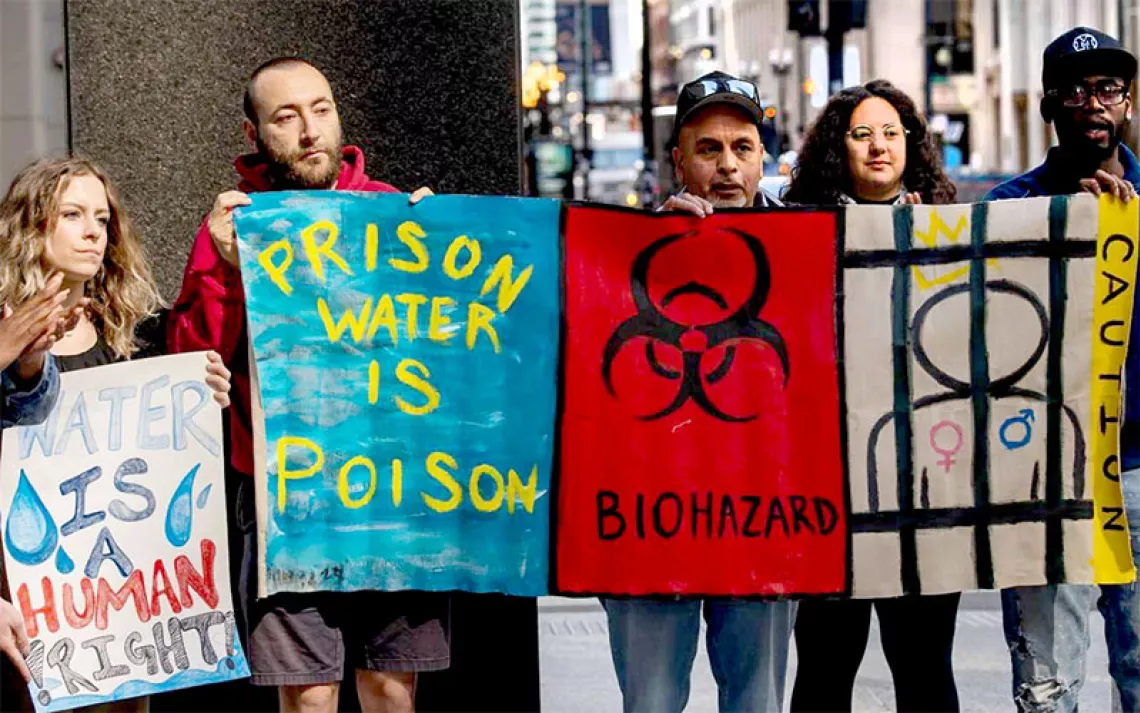A Year of War: An Energy Justice Take on Russia’s Invasion of Ukraine
What Putin’s war can teach us about energy transitions and political will

A truck at a gas station in Frankfurt, Germany, on January 27, 2023. European Union governments tentatively agreed on February 3 to set a $100-per-barrel price cap on sales of Russian diesel to coincide with an EU embargo on the fuel—steps aimed at ending the bloc’s energy dependence on Russia and limiting the money Moscow makes to fund its war in Ukraine. | Photo by AP Photo/Michael Probst
One of the most brutal wars happening in the world today is officially a year old, with seemingly no end in sight. By some government estimates, over 200,000 people have died on both sides in Vladmir Putin’s war on Ukraine. His fiery speech this week makes clear that Putin is not backing down despite the many failures of his “special military operation” to subjugate Russia’s neighbor. How can we put such a war in a broader context?
Putin has weaponized energy in this war in multiple ways, most recently in a brutal fashion. Since October, repeated Russian missile and drone attacks on Ukraine’s electric system have created life-threatening energy deprivation, resulting in widespread blackouts in frigid weather and destruction of critical power plants and substations. At one point in late November, more than half the country’s energy grid was down, leaving 6 million people with outages, prompting Ukraine’s prosecutor-general Andriy Kostin to call the Russian strategy “genocide.” Multiple such barrages, often following military or political setbacks for Putin, caused blackouts during December and early 2023.
Russia also weaponized its energy dominance in the region by instituting a series of drastic cuts in oil and gas exports to Europe in the months following the invasion, creating a global energy crisis. That crisis points to a broader context of this war: It is not just a matter of genocide, national sovereignty, and international law, but also of energy justice—the need to treat access to affordable energy as a human right.
Putin’s war has exposed the fact that nations that lack access to affordable energy and those that are most dependent on fossil fuels are vulnerable. The World Bank drew attention to this problem in much of the Global South in a 2017 study that established affordable energy as a sustainability goal for lending. Despite more developed energy infrastructure, such “energy poverty” is also a problem in the North. The European Union estimates that more than 50 million people in the region struggle to afford energy services. The Russian war exacerbated the problem, boosting fuel prices, mainly from natural gas, adding 7 percent on average to household costs. Some countries, like the United Kingdom and the Netherlands, were hit harder than others.
The creeping fear last fall was whether Europe would run out of gas in winter. One PBS commentator warned of a repeat of the deadly “hunger winter” in late World War II. Indeed, after months of arbitrary cutbacks in Russian pipeline gas, which had recently grown to 45 percent of Europe’s gas market, the flow had fallen by four-fifths as of late fall. At its highest point in August, the EU saw an average sixfold spike in wholesale prices, compared with 2021. But thanks to warmer-than-usual weather, record imports of liquefied natural gas (LNG), and bloc-wide crisis planning, Europe has survived winter so far without blackouts. The seeming miracle was aided by voluntary demand reduction averaging 24 percent (exceeding EU goals) and a mix of energy subsidies for consumers and price caps. A 60 percent increase in US exports of LNG imports aided Europe’s replacement of Russian gas, as did unusually low demand from China, which was coping with a debt crisis and COVID-19.
In the UK, however, an energy crisis had already emerged months before the war due to a confluence of weather extremes, low gas storage, a Brexit-related loss of imported electricity, and a glacial response from regulators and the ruling Tory government. With no contingency plan for a spike in gas prices and a cap on wholesale prices, the UK’s loosely regulated electric system lost 31 retail energy suppliers to bankruptcy during the crisis, forcing a government bailout of Bulb, a major utility, and subsidies to other utilities to pick up customers who lost suppliers.
In a February 3 Zoom interview, UK energy advocate Joe Davies said that over 3 million households were in arrears on gas and electric bills, including many elderly people and single parents. Unlike some EU countries that capped citizens’ energy bills, the UK “price cap” does not actually limit what a family will be charged, forcing many people to choose whether to “heat or eat.” Davies, a physics doctoral student, said he had been setting aside savings to buy health insurance when the relentless rise in energy bills made the goal impossible. He joined the UK’s Don’t Pay movement, which formed last summer to push for energy protections for vulnerable citizens, and now serves as a spokesperson for the organization, which claims 260,000 members. Many supporters, including Davies, are “striking” by not paying their energy bills.
European demand for LNG rose after the invasion of Ukraine, and oil and gas companies took advantage: Many applied for new commercial bank loans to expand their operations and lobbied the Biden administration for swift regulatory approval of new projects. A new report from a nonprofit partnership led by Friends of the Earth revealed that US and Mexican Pacific gas firms had secured 45 new long-term LNG export contracts in 2022, doubling the volume of gas contracted in 2021, most with terms of 20 years or more. This was a coup for the industry, which had seen a record 600 bankruptcies in fracking companies from 2014 to 2021 because of low or volatile global gas prices, which caused lenders to pull back. A new LNG tracker designed by the Sierra Club predicts that the long-term contracts now in place for exports of LNG will raise greenhouse gas emissions by the equivalent of 355 million cars per year, which is greater than the total number of registered US vehicles.
Still, the crisis has not derailed the shift to renewables. Wind and solar actually surpassed gas for European electric utilities for the first time last year, while new coal generation was small, at only 3 percent of generation. Ember, a global energy think tank, predicts that solar and wind capacity will triple by 2026, while fossil fuels will drop by 20 percent, most of that due to cuts in use of gas.
Europe’s declining demand contributed to a more than 40 percent drop in global gas prices since New Year’s Day. Most analysts see volatility ahead for prices. This month, US gas industry leaders reported seeing increasing resistance to long-term contracts by European importers, who fear they will conflict with EU climate goals. In response, companies have been signing contracts with Asian countries, including some heavily indebted states like Pakistan and Bangladesh, which in a short time have become dangerously dependent on costly imported LNG for electricity.
Regardless of when the Russian war ends, the need for just energy policy will persist. Global LNG (often state subsidized) will remain in demand for electricity and for producing fertilizer. When energy is unaffordable, as it recently was for Pakistan and Bangladesh, blackouts, hunger, higher mortality, and often political unrest follow. Justice depends on leveraging the moral power of social movements and public institutions to demand that energy policies be both green and fair. US environmentalists have a key role to play here, as producer countries bear the responsibility to roll back this perilous expansion of LNG.
And with good reason, as the LNG boom unleashed by the war also poses risks for US climate goals. Also, expanded gas infrastructure amplifies risks for the environment and fenceline communities. “If we want to transition to renewables in our quest to mitigate climate change, we should not invest in gas infrastructure that locks us into a path of more fossil fuels dependency,” said Marla Perez Lugo, a professor of sociology specializing in energy at the University of Texas–Rio Grande Valley. Two LNG facilities planned for Brownsville, which houses a UT-RGV campus, recently generated protests by local Indigenous and other community members.
For years, US leaders have waxed eloquent over how US oil and gas will ensure a prosperous future for decades to come. But ironically, the more US LNG is exported abroad, the higher energy inflation risks become for American households, which have already weathered a 53 percent hike in costs for natural gas in 2022. So far, consumers have been buffered from global prices, but as more US gas is exported, reducing supplies at home, analysts expect the domestic price to rise to reflect global prices. Meanwhile, without a US transition, runaway climate crisis will continue to endanger prospects for a livable biosphere.
In a recent New York Times column, David Wallace-Wells noted that Europe’s renewables surge “puts to shame America’s ambition to get to 80 percent clean electricity by 2030 . . . [and] suggests at least one obvious lesson for climate: Energy transitions can move pretty quickly when there is genuine political commitment and social buy-in.” We know how green is done. It’s long past time to devote the United States’ considerable strength and newly available tools from the Inflation Reduction Act to achieve a genuine green transition.
Russia’s war on Ukraine is a brutal example of what can happen when a country wields energy deprivation as a weapon against another. It’s also the latest example of how nations dependent on fossil fuel infrastructure and market forces are vulnerable to geopolitical impacts. The more we pivot off those energy sources to sustainable, renewable energy, the more resilient we will be.
 The Magazine of The Sierra Club
The Magazine of The Sierra Club



